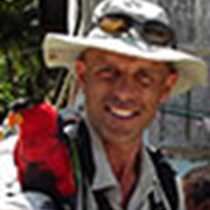At Sea to the Falkland Islands
The only way to get to South Georgia requires time at sea and our second day at sea serves to highlight the distance between South Georgia and the Falkland Islands. While neither location can be considered easily accessible, the lack of an airport at South Georgia requires a sea passage to get there.
Any time at sea in the Southern Ocean is time spent in the company of albatrosses and today was no exception. These masters of the skies treat the Southern Ocean as their backyard, covering vast distances annually in search of their prey. The royal albatrosses seen today have made the long journey from New Zealand, while the wandering albatrosses could have been the same birds we enjoyed watching at Prion Island just a few days ago. But while we make our way across the expanse of the Southern Ocean towards the Falkland Islands at a sedate 13 miles per hour, a wandering albatross can travel at speeds of 40 or 50 miles per hour and could be back in South Georgia in about 12 hours. And while we have been at sea for two days, the juvenile wandering albatross behind the National Geographic Endeavour this evening will already have been at sea for about three months and may remain at sea for a further six or seven years before returning to land for the first time. They are truly remarkable birds and it is always a pleasure to be graced by their presence.
Tomorrow we will make landfall in the Falkland Islands. We will go alongside at a dock and disembark via the gangway without needing our fleet of Zodiacs - a far cry from the wet landings of Antarctica and South Georgia. We will encounter cars for the first time since leaving Ushuaia, and trees. Such familiar objects have become strange while welcoming parties of penguins and seals have become the norm. Such is life on a voyage such as this and you can decide for yourself which you would prefer.
But it is not yet the end of this journey and after a brief dalliance with the bright lights of Stanley we will head west to explore the wilder side of the Falkland Islands.
The only way to get to South Georgia requires time at sea and our second day at sea serves to highlight the distance between South Georgia and the Falkland Islands. While neither location can be considered easily accessible, the lack of an airport at South Georgia requires a sea passage to get there.
Any time at sea in the Southern Ocean is time spent in the company of albatrosses and today was no exception. These masters of the skies treat the Southern Ocean as their backyard, covering vast distances annually in search of their prey. The royal albatrosses seen today have made the long journey from New Zealand, while the wandering albatrosses could have been the same birds we enjoyed watching at Prion Island just a few days ago. But while we make our way across the expanse of the Southern Ocean towards the Falkland Islands at a sedate 13 miles per hour, a wandering albatross can travel at speeds of 40 or 50 miles per hour and could be back in South Georgia in about 12 hours. And while we have been at sea for two days, the juvenile wandering albatross behind the National Geographic Endeavour this evening will already have been at sea for about three months and may remain at sea for a further six or seven years before returning to land for the first time. They are truly remarkable birds and it is always a pleasure to be graced by their presence.
Tomorrow we will make landfall in the Falkland Islands. We will go alongside at a dock and disembark via the gangway without needing our fleet of Zodiacs - a far cry from the wet landings of Antarctica and South Georgia. We will encounter cars for the first time since leaving Ushuaia, and trees. Such familiar objects have become strange while welcoming parties of penguins and seals have become the norm. Such is life on a voyage such as this and you can decide for yourself which you would prefer.
But it is not yet the end of this journey and after a brief dalliance with the bright lights of Stanley we will head west to explore the wilder side of the Falkland Islands.




